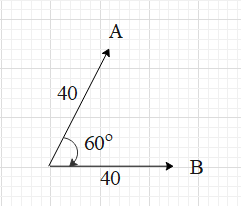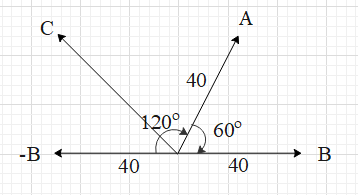
Vectors $\overrightarrow{A}$ and $\overrightarrow{B}$ are shown. What is the magnitude of a vector $\overrightarrow{C}$ if $\overrightarrow{C}=\overrightarrow{A}-\overrightarrow{B}$?

$\text{A}\text{. }40\sqrt{3}$
$\text{B}\text{. }40\sqrt{2}$
$\text{C}\text{. }40$
$\text{D}\text{. 2}0$

Answer
569.1k+ views
Hint: Draw the vector $\left( -\overrightarrow{B} \right)$ and find the angle between the vectors $\overrightarrow{A}$ and $\left( -\overrightarrow{B} \right)$. The magnitude of vector $\left( -\overrightarrow{B} \right)$ is equal to the magnitude of vector $\overrightarrow{B}$. However, both the vectors are opposite directions. Then use the formula for the magnitude of the resultant of two vectors.
Formula used: $R=\sqrt{{{A}^{2}}+{{B}^{2}}+2AB\cos \theta }$
Complete step by step answer:
The vectors $\overrightarrow{A}$ and $\overrightarrow{B}$ are given. We are asked to find the magnitude of the vector $\overrightarrow{C}=\overrightarrow{A}-\overrightarrow{B}$. This vector addition can also be written as $\overrightarrow{C}=\overrightarrow{A}+\left( -\overrightarrow{B} \right)$.
Let us first draw the vector $\left( -\overrightarrow{B} \right)$. Vector $\left( -\overrightarrow{B} \right)$ is a vector whose magnitude is equal to the magnitude of vector $\overrightarrow{B}$ but its direction is opposite to the direction of $\overrightarrow{B}$ (as shown).

From the figure we get to know that the angle between the vectors $\overrightarrow{A}$ and $\left( -\overrightarrow{B} \right)$ is ${{120}^{\circ }}$.
Let us know use the formula for the magnitude of the resultant of the two vectors, i.e. $R=\sqrt{{{A}^{2}}+{{B}^{2}}+2AB\cos \theta }$ ….. (i), where are R is the magnitude of the resultant, A and B are the magnitudes of the two vectors and $\theta $ is the angle between the two vectors.
In this case, R = C, A = 40.
The magnitude of $\left( -\overrightarrow{B} \right)$ is equal to the magnitude of $\overrightarrow{B}$. Therefore, B = 40.
And $\theta ={{120}^{\circ }}$.
Substitute the values in (i).
$\Rightarrow C=\sqrt{{{40}^{2}}+{{40}^{2}}+2(40)(40)\cos {{120}^{\circ }}}$.
The value of $\cos {{120}^{\circ }}=-\dfrac{1}{2}$.
$\Rightarrow C=\sqrt{{{40}^{2}}+{{40}^{2}}+2(40)(40)\left( -\dfrac{1}{2} \right)}=\sqrt{{{40}^{2}}+{{40}^{2}}-{{40}^{2}}}=\sqrt{{{40}^{2}}}=40$.
This means that the magnitude of $\overrightarrow{C}$ is 40.
So, the correct answer is “Option C”.
Note: Alternative solution:
The magnitude of resultant of $\overrightarrow{C}=\overrightarrow{A}-\overrightarrow{B}$, is given as $C=\sqrt{{{A}^{2}}+{{B}^{2}}-2AB\cos \theta }$ ….. (1), where $\theta $ is the angle between the two vectors $\overrightarrow{A}$ and $\overrightarrow{B}$.
Therefore, A = B = 40 and $\theta ={{60}^{\circ }}$.
Substitute the values in (1).
$\Rightarrow C=\sqrt{{{40}^{2}}+{{40}^{2}}-2(40)(40)\cos {{60}^{\circ }}}=\sqrt{{{40}^{2}}+{{40}^{2}}-2(40)(40)\left( \dfrac{1}{2} \right)}=\sqrt{{{40}^{2}}+{{40}^{2}}-{{40}^{2}}}=\sqrt{{{40}^{2}}}=40$.
Formula used: $R=\sqrt{{{A}^{2}}+{{B}^{2}}+2AB\cos \theta }$
Complete step by step answer:
The vectors $\overrightarrow{A}$ and $\overrightarrow{B}$ are given. We are asked to find the magnitude of the vector $\overrightarrow{C}=\overrightarrow{A}-\overrightarrow{B}$. This vector addition can also be written as $\overrightarrow{C}=\overrightarrow{A}+\left( -\overrightarrow{B} \right)$.
Let us first draw the vector $\left( -\overrightarrow{B} \right)$. Vector $\left( -\overrightarrow{B} \right)$ is a vector whose magnitude is equal to the magnitude of vector $\overrightarrow{B}$ but its direction is opposite to the direction of $\overrightarrow{B}$ (as shown).

From the figure we get to know that the angle between the vectors $\overrightarrow{A}$ and $\left( -\overrightarrow{B} \right)$ is ${{120}^{\circ }}$.
Let us know use the formula for the magnitude of the resultant of the two vectors, i.e. $R=\sqrt{{{A}^{2}}+{{B}^{2}}+2AB\cos \theta }$ ….. (i), where are R is the magnitude of the resultant, A and B are the magnitudes of the two vectors and $\theta $ is the angle between the two vectors.
In this case, R = C, A = 40.
The magnitude of $\left( -\overrightarrow{B} \right)$ is equal to the magnitude of $\overrightarrow{B}$. Therefore, B = 40.
And $\theta ={{120}^{\circ }}$.
Substitute the values in (i).
$\Rightarrow C=\sqrt{{{40}^{2}}+{{40}^{2}}+2(40)(40)\cos {{120}^{\circ }}}$.
The value of $\cos {{120}^{\circ }}=-\dfrac{1}{2}$.
$\Rightarrow C=\sqrt{{{40}^{2}}+{{40}^{2}}+2(40)(40)\left( -\dfrac{1}{2} \right)}=\sqrt{{{40}^{2}}+{{40}^{2}}-{{40}^{2}}}=\sqrt{{{40}^{2}}}=40$.
This means that the magnitude of $\overrightarrow{C}$ is 40.
So, the correct answer is “Option C”.
Note: Alternative solution:
The magnitude of resultant of $\overrightarrow{C}=\overrightarrow{A}-\overrightarrow{B}$, is given as $C=\sqrt{{{A}^{2}}+{{B}^{2}}-2AB\cos \theta }$ ….. (1), where $\theta $ is the angle between the two vectors $\overrightarrow{A}$ and $\overrightarrow{B}$.
Therefore, A = B = 40 and $\theta ={{60}^{\circ }}$.
Substitute the values in (1).
$\Rightarrow C=\sqrt{{{40}^{2}}+{{40}^{2}}-2(40)(40)\cos {{60}^{\circ }}}=\sqrt{{{40}^{2}}+{{40}^{2}}-2(40)(40)\left( \dfrac{1}{2} \right)}=\sqrt{{{40}^{2}}+{{40}^{2}}-{{40}^{2}}}=\sqrt{{{40}^{2}}}=40$.
Recently Updated Pages
Why are manures considered better than fertilizers class 11 biology CBSE

Find the coordinates of the midpoint of the line segment class 11 maths CBSE

Distinguish between static friction limiting friction class 11 physics CBSE

The Chairman of the constituent Assembly was A Jawaharlal class 11 social science CBSE

The first National Commission on Labour NCL submitted class 11 social science CBSE

Number of all subshell of n + l 7 is A 4 B 5 C 6 D class 11 chemistry CBSE

Trending doubts
What is meant by exothermic and endothermic reactions class 11 chemistry CBSE

10 examples of friction in our daily life

One Metric ton is equal to kg A 10000 B 1000 C 100 class 11 physics CBSE

1 Quintal is equal to a 110 kg b 10 kg c 100kg d 1000 class 11 physics CBSE

Difference Between Prokaryotic Cells and Eukaryotic Cells

What are Quantum numbers Explain the quantum number class 11 chemistry CBSE




